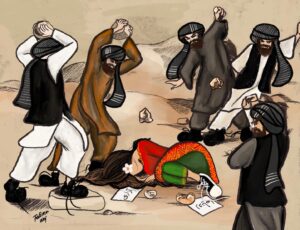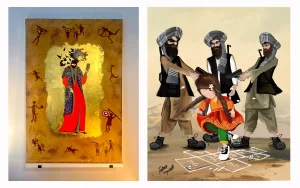Amid the Taliban’s strict restrictions on women’s freedoms, a growing number of Afghan women artists are using their talents to voice resistance, resilience, and hope. Their work, ranging from poetry and painting to digital art and music, serves as a powerful medium to challenge oppression and inspire change, even in the face of severe risks.
Since the Taliban’s return to power in August 2021, women’s participation in public life has been drastically curtailed. Girls have been banned from secondary and higher education, and women are largely excluded from employment, public spaces, and artistic expression. In this environment, art has become a subversive tool for many Afghan women, providing a way to express dissent and preserve their identity.

One prominent example is Fatima Wojohat, a painter from Herat, who creates works that depict women in traditional Afghan attire standing defiantly against stark, oppressive landscapes. “Through my art, I show what we are enduring and how we will persevere,” Fatima Wojohat.
Others, like anonymous musicians and poets, have turned to social media to share their creations, often under pseudonyms. Their themes center on loss, resilience, and the yearning for freedom, striking a chord with audiences inside and outside Afghanistan.

International organizations and diasporic Afghan communities have amplified these artists’ voices by showcasing their work abroad. Exhibitions, virtual galleries, and online platforms are being leveraged to connect these women with a global audience, shining a spotlight on their plight while celebrating their creativity.
However, these acts of resistance come with considerable risks. The Taliban has previously targeted artists and activists for defying their rules. Despite this, the woman’s determination remains unshaken.
Observers say that this wave of creative resistance highlights the enduring spirit of Afghan women, showing that even under strict authoritarian rule, the arts remain a formidable force for resistance and cultural preservation.
